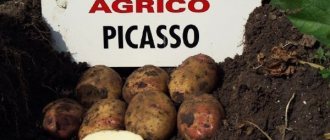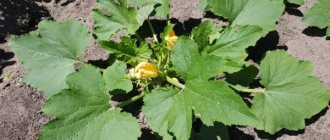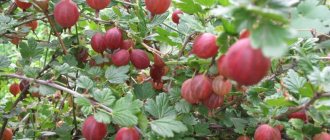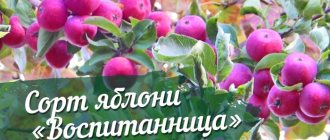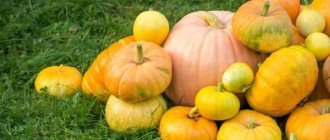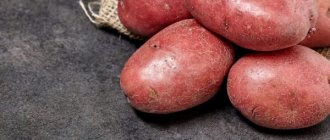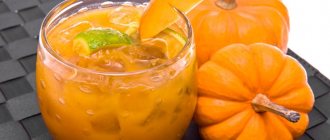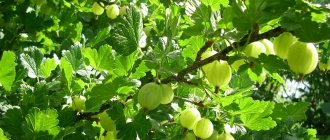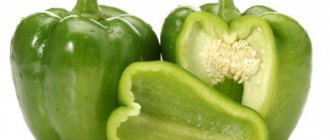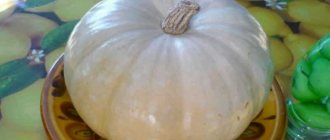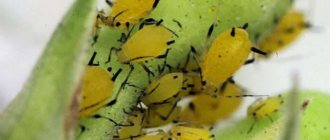Characteristics and description of butternut pumpkin
Butternut is valued for its special taste. As the culinary description says, the flesh of the raft has a nutty flavor, dense consistency, and a sweetish aroma. Pumpkin can be stored for a long time, so it is widely grown as an agricultural crop. “Butternut” refers to early ripening varieties; the standard life cycle until reaching technical maturity is 3-4 months.
Culinary experts value the vegetable because of the special arrangement of its seeds, which are concentrated only in the lower part of the elongated pear-like fruit. The rest of the pulp does not require additional cleaning.
There are two varieties of butternut squash: bush and climbing. The length of the shoots of the first is 1.5 m, the second - 2.5 m. The width of the leaves of an adult plant is 30 cm. The flowering of the crop begins in June, the inflorescences are yellow and large. Productivity up to 15 ovaries. Ripe fruits reach a weight of 1.5-2.5 kg.
The variety is not frost-resistant and can die even at temperatures below +10 °C. On the other hand, the plant is almost not susceptible to disease if the growing conditions are observed.
Which varieties to choose
Butternut varieties and hybrids are constantly on sale from companies involved in the sale of seeds. The butternut squash, the photo of which is presented below, helps you understand what its fruit looks like.
All commercially available varieties have the same growing requirements. They form lashes of different lengths, on which the ovary constantly appears. The varieties differ:
- according to ripening time;
- size and weight of the fetus;
- sugar content in the pulp;
- shades of color and taste;
- the amount of dry matter in the pulp;
- seed chamber;
- pulp density;
- crust thickness;
- storage ability.
A description of the varieties of butternut squash will help you choose a crop suitable for your place of residence, grow it on your site to enjoy its special nutty taste:
- The Cello variety belongs to the strongly climbing mid-season varieties. Pumpkin reaches a weight of up to 8 kg, ripening on the 110th day. The fruit has a thin pink-beige rind. Pumpkin surprises with its dense, oily pulp, bright orange in color, and sweet in taste. When cut, the fruit emits a distinct fruity aroma. The seed chamber is small, with a small number of seeds. Keeping quality is good.
- Pearl pumpkin, a short-climbing plant with elongated cylindrical fruits. The maximum weight does not exceed 7.5 kg. The crust is colored a light yellowish-orange hue. When cut, the flesh is rich in pigment, orange with a red tint. The seed chamber is very small, containing small flat seeds. The pulp is tender and juicy. Productivity up to 15 kg/m2.
- Matilda pumpkin is famous for its high carotene content. This is a late variety that ripens while lying indoors. The fruit will be ready for consumption no earlier than December. Maximum fruit weight 5 kg. The ripe fruit has orange pulp with a sweet taste and honey aroma. Stores well until spring.
- Pluto pumpkin bears small fruits of no more than 1.5 kg. This variety can be grown in areas with short summers. The fruits ripen 3 months after sowing the seeds in open ground. Pluto is stress-resistant and quickly sets fruit. This variety has dense, bright orange pulp with a pleasant aroma.
- Pumpkin Pastila-Champagne weighs up to 3 kg. This variety has a pink fruit rind with a vaguely drawn mesh and a nutty-tasting, bright orange flesh. Has excellent keeping quality.
- Pumpkin portioned Nut butter grows weighing up to 1 kg. This is another variety that produces yields in areas with risky farming. Ripens on the 90th day. One bush bears up to 30 fruits. Pumpkin is pear-shaped. The pulp is dense, bright, oily, with a bright nutty flavor. Stores well throughout the winter.
- Pumpkin Prikubanskaya is a medium-climbing variety that produces a yield of 5 kg/m2. Fruits weighing up to 5 kg ripen 136 days after sowing the seeds. The fruit is cylindrical, elongated, pear-shaped, forming a slight thickening at the floral end. The light orange-brown butternut squash has a smooth surface with a mesh pattern. The pulp of this variety is red-orange, sweetish in taste with a pleasant fruity aroma. The taste is average. The skin of this butternut variety is thin, so pumpkin can be stored for no more than 3 months after harvesting. Frozen fruits spoil quickly.
When choosing a butternut squash variety, consider how you will use this healthy fruit. Varieties with large fruits are needed in a private home, where succulent food is fed to domestic animals. Small portioned pumpkins are suitable for lovers of baked pumpkin living in a city apartment. Medium-weight fruits are good for making baby food, juices, and casseroles.
Cut pumpkin can be stored for no more than 5 days. Then its tender flesh rots. Drosophila loves to breed on it, which causes rapid spoilage of the vegetable.
Advantages and disadvantages of the variety
The culture is popular due to the following advantages:
- Thin skin. The fruit is easy to cut and no additional effort is required.
- The seeds are concentrated at the bottom of the pumpkin and are easy to remove. Approximately 60% of the pulp contains no seeds at all.
- Pleasant nutmeg aroma and original taste. There is no specific pumpkin smell. The pulp is well suited for both salty and sweet dishes. The most popular recipes involve baking in the oven with cinnamon and adding to porridge with honey.
- Small fruits. Pumpkins reach no more than 2.5 kg, making them convenient to store and eat. One piece is completely consumed for one dish.
- Long shelf life at room temperature. Butternut can remain fresh for 6-7 months, until spring.
Unfortunately, the variety also has a number of disadvantages that complicate cultivation:
- Requirements for temperature conditions. The plant will not develop in the northern zone in open ground, since it does not tolerate even slight cold snaps at night. The only way out of the situation is early planting under cover so that the pumpkin has time to bear fruit before the onset of September coolness, characteristic of the northern regions of Russia.
- Need for constant care.
- Demanding requirements for soil composition.
Useful properties of this pumpkin
Where did such an interesting vegetable come from? This is a consequence of crossing wild African and butternut squash. It is a very common variety all over the world, but it is just beginning to appear here. Why is butternut squash starting to gain popularity in Russia? The reason is simple - the usefulness of the vegetable, because it consists of coarse dietary fiber, which improves intestinal function and cleanses it of most waste products. If you suffer from constipation, consume this vegetable regularly and it will regulate your bowel movements well. What else is characteristic of butternut squash? The beneficial properties to some extent depend on its low calorie content.
Growing seedlings
Seedlings should be sown in late April or early May. A month before this, it is recommended to place the seeds in a warm place to increase the number of female inflorescences. A few days before planting, they need to be washed in warm water, dried, and then left in the refrigerator for 1-2 days. Next, the seeds are sown in separate peat pots. Until the first shoots appear, the containers need to be covered with polyethylene to create a mini-greenhouse.
The seedlings can be transplanted into open ground after at least three leaves have formed.
Cosmetic benefits
I don’t know anyone who wouldn’t want to have healthy skin and beautiful shiny hair. Butternut squash is ready to come to the rescue here too, because it is rich in provitamin A, vitamins C and E. These compounds prevent premature aging and maintain the natural level of acidity (pH) - a natural barrier against acne and skin infections.
With regular consumption of this variety of pumpkin, you will no longer be afraid of early wrinkles and age-related pigmentation.
Among the beneficial properties of nutmeg pumpkin, there is one related to the beauty and health of hair. The biologically active substances of this product promote hair growth, protect it from fragility, strengthen follicles, get rid of dandruff, prevent the appearance of split ends, soften and nourish an overly dry scalp.
To enhance the positive effect, use our tips for making homemade pumpkin cosmetics.
Planting seedlings in the ground
The optimal place for planting is sunny, not windy, without weeds. The sprouts can be planted when they reach a height of 15 cm. The weather should be warm outside; it is best to start replanting in early June. For each plant, prepare a hole with a 10 cm layer of sand (drainage). The minimum distance between holes is 50 cm, between rows - 50-60 cm.
Planting should be done in the evening. For the first 3-4 days, water the plant daily, without touching the stem and foliage.
The nutritional value
Butternut squash is surprisingly low in calories, has no cholesterol or saturated fat, and is high in fiber, protein, antioxidants, phytonutrients, vitamins and minerals. That's why many nutritionists advise their clients to eat butternut squash dishes to combat excess weight and high cholesterol.
- Vitamin profile: A, C, E, B6, K, folic acid, thiamine and niacin.
- Mineral profile: calcium and magnesium, phosphorus, potassium, zinc, copper, manganese and selenium.
Butternut squash is also high in flavonoids (bioactive plant compounds) such as α- and β-carotenes, lutein, and cryptoxanthin-β.
Caring for the Butternut variety
For proper development of ovaries, it is necessary to maintain a temperature of at least +15 °C. In cold regions, you will need a transparent film cover at night. Pumpkin requires regular watering; the soil should not dry out or crack. It is recommended to add potassium humate to the aqueous solution every 7-10 days. During the fruiting period, Fertik fertilizer is used 2 times, at the beginning and at the end. The climbing variety needs to be tied to trellises.
Marble
Description of the variety. The pumpkin is large-fruited, long-climbing, tolerates transportation well and has a shelf life. Not resistant to drought. Late-ripening: 130-140 days pass from planting seeds to harvesting. The length of the lash is up to 3 m. The yield is 1.6-3 kg per plant.
The fruit has a hard, wrinkled green bark with noticeable spots of light color and juicy, friable egg-yellow flesh, has a spherical shape and weighs 4-5 kg. Well segmented. Marble variety pumpkins contain vitamins A, B and E, as well as carotene, potassium, magnesium and other useful elements. The sugar content of the fruit is about 10-12%.
Diseases and pests
To protect against pests and diseases, the bush should be sprayed with Aktara and Fundazol every 2 weeks. In case of infection, it is necessary to take specific actions, depending on the problem that has arisen.
| Disease/Pest/Leaf Damage | Symptoms | Corrective measures |
| Bacteriosis | Brown spots on fruit or plant. | Remove the affected areas, preferably the plant itself. |
| Powdery mildew | White spots appear, then leaves curl. | Spray with 1% copper sulfate until the signs disappear. |
| Root rot | Yellowing, fading. | Sprinkle the lower shoots for rooting. |
| White rot | Whiteness on the stem and foliage, turning to black. | Cut out the affected areas and sprinkle with ash. |
| Aphid | Black or green pests on the stem. | Spray with garlic solution. |
| Spider mite | Cobwebs on shoots. | Use garlic solution for spraying. |
Popular varieties
Muscat pumpkin - the variety is consistent with the name of the species. Its pumpkins resemble a bell with an elongated top. The variety is late, the fruits ripen 125-135 days after the appearance of the entrances. There is no fiber in the pulp. Pumpkins are smooth orange-yellow with a vaguely defined pattern. The pulp is orange-red, tasty and aromatic. Used for processing and fresh consumption. The variety is very valuable, as it has a high content of provitamin A. Well suited for preparing baby food, juices and dietary products
Muscat de Provence is a pumpkin that has increased productivity, bred in France. Mid-season variety, fruits ripen 110-115 days after germination. It has a powerful plant that is resistant to diseases. Pumpkins have an original flat-round shape with pronounced segments. The bright orange pulp accumulates a high amount of sugars - up to 10%. The weight of the fruit, depending on the planting density, varies from 3-4 kg to 6-8 kg. Muscat de Provence pumpkin produces beautiful thick-walled pumpkins that are highly attractive when sold on the fresh produce market. They store well and are also great for making purees and juices.
Vitamin Pumpkin. The variety is distinguished by cylindrical, cube-shaped fruits. It has a late ripening period of 125-130 days, but brown-brown pumpkins with a pink tint reach a size of 6-8 kg. The almost red pulp with a high content of carotene accumulates up to 11% sugars, is very tasty and crispy. The fruits have a short shelf life, but are well suited for dietary nutrition and the preparation of children's juices and purees.
Muscat pumpkin Zhemchuzhina is an unusual variety that stands out among long-climbing mid-late varieties for its resistance to low temperatures and other unfavorable growing conditions. Cylindrical yellow-orange pumpkins reach a weight of 5-8 kg. The pulp is orange, dense, very tasty, excellent for dietary nutrition and making juices. Zhemchuzhina pumpkin is a high-yielding variety whose fruits have good transportability and a long shelf life.
Harvesting and storing butternut squash
Technical ripe fruits can be harvested in early September. If the rainy season begins early, you will have to remove the pumpkins ahead of schedule and leave them to ripen in a dark and dry place. The pumpkin should be a soft orange hue.
Store at room temperature. Avoid getting moisture on the peel. If there is high air humidity in the room, you should not leave butternut squash in it.
Chit
Description of the variety. The pumpkin is climbing, tolerates transportation well and is characterized by keeping quality. It is characterized by high resistance to cold, temperature changes, and anthracnose. The variety is mid-season: 115-125 days pass from planting seeds to harvesting. Productivity – 5-7 kg per plant.
The fruit has a hard grayish bark and yellow-orange pulp of medium density, has a spherical, slightly flattened shape and weighs 2.5-3 kg, with weak segmentation. Pumpkins of the Kroshka variety contain a lot of useful substances. The sugar content of the fruit is more than 9%.
Mr. Summer Resident advises: the benefits and harms of butternut squash
The fruits are low in calories, so they can be included in the diet when losing weight, if you do not cook them over a fire, but bake them. The rich content of microelements helps strengthen the cardiovascular and nervous systems. Nutrients stimulate the removal of waste, toxins, and excess fluid from the body. A number of elements reduce cholesterol.
The “butternut” has not only benefits, but also harm. The product has a bad effect on the condition of patients with gastritis, ulcers or other gastrointestinal disorders. The pulp increases the acidity of the stomach, leading to an increase in the percentage of sugar in the blood.
Winter sweet
Description of the variety. The pumpkin is large-fruited, cold-resistant, tolerates transportation well and has a shelf life. It is resistant to drought, but is sometimes susceptible to white mosaic, gray mold and fusarium. Late-ripening: 130-140 days pass from planting seeds to harvesting. The length of the lash is up to 3 m. Productivity is up to 30 kg per plant.
The fruit has a hard gray bark with slightly noticeable spots of different colors and juicy friable egg-yellow flesh, has a spherical, slightly flattened shape and weighs 6-12 kg. Well segmented. Winter sweet pumpkins contain a large amount of vitamins and microelements; the sugar content of the fruit is about 10%.
How to grow
Butternut pumpkin is a heat-loving plant. Let us remind you that you can plant it in the ground with seeds only in the southern regions, where there are no frosts in mid-autumn. In the middle zone and northern regions, the seedling method is used.
Seed preparation
First of all, pumpkin seeds are heated. Do this for 1-2 months near a heating device or stove. Warming up increases the chances of getting more female flowers, and therefore a good harvest. Then the planting material is prepared.
Preparation consists of a number of activities:
- Seed selection. Empty seeds are discarded at this stage. To determine whether the seeds are empty or not, they are placed in a salt solution. Those that do not drown are empty and not suitable for planting.
- Hardening. The seed, wrapped in a damp cloth, is kept in the refrigerator for three days. This helps the seedlings adapt more quickly to weather changes.
- Disinfection. Before planting, the seeds are soaked for 10 hours in a weak solution of potassium permanganate or water with aloe juice.
Planting by seeds
To plant seeds earlier, warm beds of compost or manure are prepared in the fall. Immediately make holes and fill them with fertile soil. When the beds are ready, they are covered with transparent polyethylene. This allows biofuel to begin heating the soil as early as March.
In mid-May, pre-sprouted seeds can already be planted in holes to a depth of 2-3 cm. The film is not removed, but holes are made in it above the hole.
Seedling
Seeds are planted for seedlings in early May. Most gardeners use special pots with nutritious soil. Seedlings require regular moisture, but excessive moisture should be avoided. The pots with seeds are covered with film, creating a greenhouse effect, but ventilation must be provided periodically.
Landing
It is better to plant seedlings in loamy soil in the sunny part of the garden. The recommended distance between the beds is 0.6-0.7 m. The optimal period for planting seedlings in the ground is the beginning of June, when frosts are no longer expected.
For weight loss
For those trying to lose weight, butternut squash will be a delight. This is one of the most delicious low-calorie foods with a good dietary reputation and high fiber content, which stops a rumbling stomach and hungry impulses to rummage in the refrigerator. Protect your body from overeating.
A good dietary effect can also be obtained from pumpkin juice. Read How to drink pumpkin juice to lose weight.
